Saturday 31 May 2014
Which Moto smartphone to buy? Moto E Vs Moto G

New Delhi: Motorola is eyeing and trying to grab a slot in the budget smartphone market. On May 13 2014, Motorola launched Moto E, an affordable smartphone at Rs 6,999 to undercut the existing price competition in the smartphone market. Interestingly, the phone is available only online through Flipkart. Motorola has set the price to compete directly with home-grown brands such as Micromax and Karbonn in this price category.
Another smartphone by Motorola, Moto G was launched in February this year at Rs 12,499 and has set the benchmark for smartphones with good performance, affordability and a decent built.
With the launch of Moto E, the consumers will now be confused between Moto G and Moto E and the company hopes that the sales momentum will continue which was generated with the launch of Moto G. Pricing will be the major factor to decide between the two gadgets.
Moto E is a great buy if you don't want a front facing camera or you don't play graphic intensive games. Go with Moto G if you are a person who uses front camera for video chat or you like to take selfies. Moto E also has dual SIM slot which is a key feature.
Both the smartphones are well-built and durable. The Moto G also has water repellent coating, an additional feature that Moto E lacks.
Moto E comes with just 4GB internal storage and you need to buy a memory card. Moto G, on the other hand, comes with a 8GB storage. Both the phones offer a decent battery life.
Moto E has a 4.3-inch display with 960x540p resolution making it a high quality resolution. It has a 5MP camera. Although, both the smartphones run on Android 4.4(KitKat) OS and offer best software experiences.
Overall, it may be worth shelling few thousands extra to get a Moto G over a Moto E if you want some extra features. But if you're okay with the tradeoffs that the phone makes and would rather save some money, Moto E is great bargain.
Labels:
5c,
5s,
android,
Cellcom,
Cellular,
iphone,
iphone4,
mobiles,
phones,
smart,
smartphones,
telecommunication
Friday 30 May 2014
Acer pushes out new smartphones for Q3, targeting high to low end
Taiwanese PC maker Acer has made another big push into the smartphone market, and unveiled four new models under its “Liquid” brand that will arrive in the third quarter.
While Acer did not mention product pricing in Friday’s announcement, the four handsets come with both high-level and mid to lower-level specs.
Among them is a new 5.7-inch smartphone, called the Liquid X1, that’s designed for 4G LTE networks, giving it download speeds of up to 150 Mbps. The phone, targeted at the high-end market, has a 1280 by 720 pixel resolution and contains a 13-megapixel rear-facing camera and a 2-megapixel camera in the front.
Inside the Liquid X1 is an 8-core 1.7 GHz processor from Taiwan’s MediaTek, and a 2700 mAh battery. The device itself weighs 160 grams, runs Android 4.4, and has 2GB of RAM, along with 16GB of memory. Acer has included a microSD card slot on the phone for expandable storage.
The Liquid X1, positioned as a so-called “phablet”, comes with a feature called “Acer Zoom Fit” that can adjust the phone’s user interface to a smaller 4-inch size for one-hand operation. In addition, the Liquid X1 offers a splitscreen function, letting users operate different mobile apps at the same time.
On Friday, the PC maker also announced two other Android phones, the Liquid E700 and E600, both of which come with 5-inch screens. In the E700’s case, Acer built the device with a large 3500 mAh battery, and the ability to hold three SIM cards.
The E700 has a screen resolution at 1080 by 720, and uses a quad-core 1.3 GHz processor from MediaTek. It comes with only 1GB of RAM and 4GB of storage, but the phone has a microSD card slot for more memory. For picture taking, the E700 has an 8-megapixel rear-facing camera, and a 2-megapixel front-facing camera.
The phone’s sibling, the E600, has a more modest screen resolution at 854 by 480 pixels, and comes with a smaller battery at 2500 mAh. Another difference is that the E600 is built for 4G LTE networks, and uses a 1.2 GHz quad-core processor from Qualcomm.
The fourth phone Acer unveiled is a budget Android handset called the Liquid Z200 that’s meant for first-time smartphone users. The no-frills device comes with four preset profiles, including one targeted at younger users and another for the elderly. The profiles offer a simpler layout and streamlined features for quick access to phone calls and text messaging.
In terms of specs, the Z200 has a 4-inch screen at a 800 by 480 resolution. Under the hood is a dual-core 1.0 GHz MediaTek processor, with 4GB of storage and 512MB of RAM. A 2-megapixel camera is located in the back, and the phone has a 1300 mAh battery.
Acer made no mention of what markets the company is targeting, but in the past it released phones to countries in Europe and Asia. With the PC market continuing to shrink, the company is expanding in mobile devices, and earlier this year unveiled its first wearable product, called the Liquid Leap, which will also arrive in the third quarter.
The company has yet to become a major smartphone player. But it is hoping the devices will help drive adoption of its consumer cloud services, called ”Build Your Own Cloud.” These services will let users automatically synchronize files and multimedia between different products, including PCs, smartphones and tablets.
The PC maker is expected to show off the new phones at the Computex trade show in Taipei next week.
Labels:
5c,
5s,
android,
Cellcom,
Cellular,
iphone,
iphone4,
mobiles,
phones,
smart,
smartphones,
telecommunication
Thursday 29 May 2014
Teenagers Do Not Need Smartphones, So They Should Pay for Them. Discuss.

Two weeks ago, I took to this space to ask four key questions about cars and teenagers and suggest four possible ways of paying for what they drive.
As is often the case with this crowd of readers, the resulting commentary was illuminating. One of my favorite bitscame from the shellshocked parent for whom the car conversation was unfathomable. Her family had not even been able to build consensus around what constituted responsible use of the resident teenager’s mobile phone.
The phone is its own financial discussion, or at least it should be. Another reader, Mary Kay Russell, the mother of four boys in Naperville, Ill., wrote to me for feedback on her own approach, one she says no other family she knows actually uses.
Her theory is this: Teenagers do not need smartphones. So if they want devices that do much of anything beyond voice calls and text messages, they ought to pay for the fancy phone and the necessary data plan themselves.
We’ll call this the Russell Plan. Here’s how it fits in with the want-versus-need negotiation that’s in the background of almost every discussion with kids about money.
First, is a basic phone necessary at all? In 2014, I think it is. Sure, you may be fine with not being able to reach your children whenever you want. Maybe you even think it’s good for them to not be able reach you right away if they get into a jam.
Still, you do have to consider their friends. If all of them have phones, the planning of social and extracurricular activities may happen mostly through text messages. Coaches and other adults in their lives, knowing that many teenagers don’t bother much with email, may have already defaulted to group texts. If that’s the case in your circles, a basic phone is probably a requirement. Curse modernity, but there you go.
Most parents pay for the things their kids need if they can afford them. So in this instance, it probably means upgrading your mobile phone service to some kind of family plan, which may come with unlimited voice calls and text messages. This might add $30 or so a month depending on the package you have before the first child gets a phone. The Russell Plan in Naperville calls for picking up this tab.
Smartphones and their associated data costs are another matter though. Do kids need Instagram and a store full of apps? Probably not. A mapping app may help teenagers find their way while driving, but it’s probably better for them to learn to navigate the road with their heads up anyhow. Buy them a Rand McNally paper atlas to consult before putting the car in gear, or a good local map.
Because a smartphone isn’t a true need, the Russell Plan means that their boys make do with a bare-bones phone. Parents will want to add their own rules about billing overages (if calls or texts are not unlimited) and the person responsible for the cost of replacing lost or broken phones (the kids, not the grown-ups). This isn’t an etiquette column, but I liked the additional guidelines in anintrafamily phone contract that went viral last year.
As for smartphones, the Russell boys were welcome to have them as long as they paid for the phone upgrade and wrote a $360 check for the first year’s data charges ahead of time. The eldest son first decided to do this at age 21, but none of the others have made the leap yet.
Is all of this too harsh? Should parents really make their children buy themselves everything that they merely want? Every family makes their own decisions about this, but my reporting over the last few years has turned up a number of perfectly reasonable mothers and fathers who believe that teenagers should save like adults do and pay for any larger objects of desire.
Or, the older children could wait to receive these things as gifts. Ms. Russell said that a smartphone and a year of data could have replaced a birthday present and much of the Christmas budget, but the boys weren’t willing to give up the gift pile under the tree or commit to paying for the data plan in future years.
All of this suggests that the Russell kids really didn’t want smartphones all that much and must not have needed them at all. Which leads Ms. Russell to wonder why so many parents she knows write checks for the phones and data for their own teenagers without stopping to question the purchases.
What is she missing? And how do you handle the mobile phone bill and budget with your children?
Ron Lieber is the Your Money columnist for The New York Times. He is the author of the forthcoming “The Opposite of Spoiled,” about parenting, money, values and raising the kinds of children all parents want to push out into the world, no matter how much money they have (Harper Collins, February, 2015). He hosts regular conversations about these topics on his Facebook pageand welcomes comments here or privately, via his website. The Opposite of Spoiled appears on Motherlode on alternating Thursdays.
Labels:
5c,
5s,
android,
Cellcom,
Cellular,
iphone,
iphone4,
mobiles,
phones,
smart,
smartphones,
telecommunication
Wednesday 28 May 2014
Jawbone Patents Body Fat Percentage Measurement Using Smartphones, Tablets And Wearables

Device makers are increasingly looking for ways to move the health tracking market forward, and a new patent filing from device maker Jawbone offers a clue to what might come next. Jawbone had a patent application published by the USPTO recently that describes a method for measuring body fat percentage with existing devices, including smartphones and tablets, or a wristband like the UP24, using the sensors said hardware already carries on board.
The patent describes how the system would use things like the display, accelerometer, gyroscopes, microphones, GPS and more to tell the user how best to place the device to measure body fat percentage. It would do this by broadcasting an “impulse” using onboard vibration motors and measuring the response that comes back; put simply, the phone, tablet or other gadget would jiggle your fat and measure the frequency of the jiggles to provide you with an estimate of body fat percentage.
Jawbone’s patent would work in tandem with an app on the device, which could make up part of a comprehensive health tracking app or one made specifically for the purpose of body fat percentage measurement. This would represent a new measure tracked by devices – traditional ways of calculating body fat for mobile health monitoring platforms involves use of a dedicated external device, like the Withings Smart Body Analyzer digital scale, for instance.
The patent is credited to Aza Raskin, the founder of Massive Health, a company Jawbone acquired in 2013 with an eye to bringing on its design-focused talent.
Labels:
5c,
5s,
android,
Cellcom,
Cellular,
iphone,
iphone4,
mobiles,
phones,
smart,
smartphones,
telecommunication
Tuesday 27 May 2014
LG Announces Android 4.4 KitKat Update for G Pro Lite and Optimus L9 II

LG announced the Android 4.4 KitKat update for its LG Optimus L9 II and LG G Pro Lite handsets, skipping the Android 4.3 Jelly Bean OS update for both the smartphones.
First spotted by The Droid Guy, the announcement was made on LG Italy's Facebook page, which stated that the Android KitKat OS update for LG Optimus L9 II should arrive in the coming weeks, while the LG G Pro Lite smartphone should receive the same update by the end of Q2.
However, as GSMArena notes, users in Slovakia are reporting that the LG Optimus L9 II has already started receiving the update. The LG Optimus L9 II was launched in August last year, with Android 4.1 onboard. The LG G Pro Lite was also launched with Android 4.1 in October.
The latest Android 4.4 Kitkat OS is said to bring stability improvements for the LG handsets along with an improved battery performance and some bug fixes. One of the key features the Optimus L9 II andLG G Pro Lite would be receiving as a part of the update is the recently introduced KnockCode.
To recall, KnockCode is the further enhancement of the company's own KnockOn feature, which it had patented in 2008. LG says that the new Knock Code feature provides a higher layer of security and convenience to users over conventional password and pattern-based security options. The feature debuted on LG G Pro 2 smartphone during the MWC 2014 event.
Before this, LG updated its LG G2 international variant with Android 4.4 Kitkat OS in March. The update supposedly brings restyled status and navigation bars; new full-screen mode; improved security features; improved battery efficiency (now comes with battery-saving location mode), andGoogle Cloud Printer support.
Labels:
5c,
5s,
android,
Cellcom,
Cellular,
iphone,
iphone4,
mobiles,
phones,
smart,
smartphones,
telecommunication
Monday 26 May 2014
Smartphones: Why it's easy to switch

Remember back when the Palm Treo first hit buyers’ hands? The thin (for its time) handset with the tiny screen hinted at the great smartphones to come. Owners discovered, often for the first time, the delight of having a smartphone that could do many things. This paved the way for the arrival of Apple’s iPhone.
The iPhone revolutionized the mobile space with its slab form and simple interface. The OS was rapidly accepted by consumers as it gave point-and-click operation to the tasks that quickly became standard. Surfing the web, working with email, using Facebook, and all the functions we’ve come to love having on our phones, were all front and center on the iPhone.
Fast forward to today and it seems that smartphones are losing their identities. Sure, there are lots of them out there, iPhones, Samsung phones, Windows phones, etc., but none of them has anything to set them apart from the lot.
The slab
Smartphone makers are going crazy trying to come up with a hardware angle that will ignite the passion needed to create the next big phone. They are totally failing in this regard, in large part to the fact that the smartphone is still just a slab.
The original iPhone was a big deal due to its simple slab form, and that’s what every OEM has adopted. Pick up the latest Android phone, Samsung’s or anybody else’s, and it’s a slab. So is the latest iPhone, and every Windows Phone at the store. They are all slabs, pure and simple.
Since all smartphones have the same form, the only way OEMs can stand out from the rest is to make subtle changes. This is attempted either by changing the edges of the slab, adding simple hardware controls, putting a better camera, or offering different colors for the casing.
Those aren’t significant changes, and the inability of any smartphone to break out of the mold is proof of that. Put round edges on a smartphone to be different and nobody really cares. Make a bright yellow phone and the majority of prospective buyers say “ho-hum”. The changes are too superficial to make any phone stand out from the rest.
Even Apple’s Touch ID, the fingerprint sensor used to unlock the phone, failed to create the buzz that the company wanted. Pundits and analysts oohed and ahhed but the buying public shrugged its collective shoulders. It's a nice feature but nothing special.
Samsung put health sensors in its latest Galaxy S5 smartphone to try and breach the boring divide, but that failed miserably. The design chief resigned over the lack of interest in the S5 handset. That’s about as big a failure to set your phone apart from the rest as you can get.
The fact is the smartphone has become so ubiquitous, so commonplace, that it is no longer held in a special place with consumers. They’re all basically the same, and factors other than features and design now determine which one we buy.
The apps
With hardware pretty much the same across smartphone product lines, that leaves software to set them apart. The major smartphone platforms do things differently than the others to differentiate from the rest. The problem is, they still all do the same things, however different the approach.
Most of the buying public doesn’t look at the mobile OS to determine which one they like best. Smartphone usage has become so ingrained in owners’ lives that they now just think about what they do with the phone, not how they do it. It’s no longer a case of which phone does some things better, it’s now a question of “can this phone do this and that?”
The problem for OEMs is that the answer to that question is “yes it can”, no matter what brand of phone or what platform it runs. They all do the same things, and do them fairly well. Checking email, Facebook, and Twitter is just as good on all phones currently available. There is no unique function on one that sets the phone apart.
Some smartphone owners will tell you they love their widgets or live tiles as they set them apart from the competition. They’re correct in that view, but that is overshadowed by the similarity across all platforms in the things owners actually do with phones.
One thing we’re seeing more often — long time enthusiasts of one smartphone/platform try switching to the competitionand discover they like it just as much as their former favorite. This is because when exposed to another solution, they realize they can do the same things on it they’ve always done. They may do them better on the new platform which really surprises them, or it may be mostly the same experience. The realization hits them that smartphones are basically the same when it comes to functionality.
General malaise
The lack of distinction among smartphones and the software that runs them has resulted in buyer’s fatigue. Outside of small pockets of enthusiasts there are no big groups anxiously awaiting the next smartphone, not even Apple’s. The buying public has become a passive audience concerning what’s coming next, and that is a big problem for OEMs.
With both hardware and software basically the same in the smartphone space, it’s not clear how OEMs can build one that rises above the rest and gets buyers excited. For consumers, it’s become a simple case of what we can do on our phone that determines how we like it. And we all do pretty much the same things.
Labels:
5c,
5s,
android,
Cellcom,
Cellular,
iphone,
iphone4,
mobiles,
phones,
smart,
smartphones,
telecommunication
Saturday 24 May 2014
Android 4.5 Lollipop may be a desktop OS-like mobile firmware

The next generation of Android OS dubbed as 4.5 Lollipop will be like a desktop OS packed into a mobile device.
Google is about to unveil the next flavor of Android OS at the company's annual I/O Conference on June 25. Rumors claimed that the upcoming mobile software will have the functions of a desktop OS coming to smartphones and tablets.
Reports claimed that Android 4.5 will redesign its user interface. According to a report of Android Police, the company was currently experimenting with Project Hera, which "essentially represents Google's effort to unify the experience users have in Android, Chrome, and Search all on your Android-powered device."
The new project aimed to alter the experience of users who run Google's Search and Chrome apps on their Android phones. It is also expected that Google will integrate HTML 5 that will enable the users to multi-tasking windows. The project was inspired by Ubuntu's Edge and Google wanted to ease the transition from the mobile phone to the desktop for most users.
Reports said that the new OS will allow users to start a task on the computer, then pause and leave it as a Google task card, which can be completed in one's smartphone. Moreover, Google plans to make its voice assistant OK Google to be as competent as Siri by giving it a facelift.
Fans also expected that Android 4.5 Lollipop will support the processor and graphics chipset of the smartphone. This is relevant since it was rumored that upcoming devices will soon pack upgraded processors with 64-bit architecture, which will make the processing smoother and more stable.
Android 4.5 Lollipop OS is also rumored to give emphasis to the smartphone's security as Android is being targeted by mobile malware given that the operating system is an open source. There were some apps in the PlayStore that are loaded with bloatware that make users turn to .apk or installable files instead of downloading the files in order to avoid the malware. Thus, Google is expected to resolve this issue in the upcoming OS.
Labels:
5c,
5s,
android,
Cellcom,
Cellular,
iphone,
iphone4,
mobiles,
phones,
smart,
smartphones,
telecommunication
Friday 23 May 2014
Apple, Samsung Rule U.S.Smartphones Market in Q1

The feature phone isn't totally dead in the United States but it's getting there, according to market researcher Counterpoint.
The research firm published its Market Monitor quarterly tracker report Thursday, offering up the news that smartphones accounted for more than 87 percent of all handset shipments in the U.S. by the end of the first quarter of 2014.
Of course, that means that some people are still stocking features phones and a few companies, like Samsung, are still benefitting from the non-total saturation of the market with smartphones.
Samsung was the biggest shipper of handsets in the U.S. in the first quarter, according to Counterpoint, but not the most prolific shipper of smartphones. That would be Apple, which of course only sells smartphones.
At any rate, the two consumer electronics can quibble about who's bigger on the margins. Together, Samsung and Apple accounted for two-thirds of all first-quarter smartphone shipments in the U.S. market, Counterpoint reported.
Meanwhile, quite a ways down from those lofty heights, there was a fight for a prominent also-ran spot in the U.S. smartphone market, with TCL-Alcatel passing Huawei to grab the No. 5 market share position, according the research firm.
In terms of operating systems shipped on smartphones in the first quarter, Counterpoint reported that Google's Android remained king with a 59 percent share of the market, Apple's iOS remained in the mid-30s, and Microsoft's Windows saw a bit of nice growth but still accounted for just under 4 percent of unit shipments.
The first quarter also saw inexorable takeover of the U.S. market by LTE-equipped phones take another step forward. Some 75 percent of all smartphones shipped in the quarter were LTE phones, with Apple and Samsung combining to ship more than 70 percent of them, according to Counterpoint.
There was also some jockeying for position among the big carriers in the quarter. T-Mobile passed Sprint to become the third-largest smartphone volume buyer among the carriers, trailing only Verizon and AT&T, the report stated.
As for carrier brand affiliation, both Verizon and AT&T remained strong Apple shops, with iPhones accounting for more than half of the smartphone shipments to those carriers. Sprint saw a more distributed breakdown in first-quarter unit shipments from the two giants of the smartphone-making industry, with 36 percent coming from Apple and 30 percent from Samsung.
Among major carriers, only T-Mobile saw a majority of its smartphone shipments come from Samsung, which accounted for 38 percent to Apple's 24 percent. Counterpoint also noted the South Korean company's strong position with regional carriers throughout the U.S.
Labels:
5c,
5s,
android,
Cellcom,
Cellular,
iphone,
iphone4,
mobiles,
phones,
smart,
smartphones,
telecommunication
Thursday 22 May 2014
Sony Seeds Android 4.4.2 (10.5.A.0.230) KitKat for Xperia Z/ZL/ZR/Tablet Z [FTF Links]

Sony has begun rolling out Android 4.4.2 KitKat software upgrade for its Xperia Z series handsets.
In March, Sony released Android 4.4.2 update for Xperia Z1, Xperia Z1 Compact and Xperia Z Ultra. Along with the release, Sony confirmed that similar software updates will be released for Xperia Z, Xperia ZL, Xperia ZR and Xperia Tablet Z in the middle of second quarter.
Last month, Sony changed the software update status for aforementioned Xperia Z series handsets with the next version of Android 4.4.2, which was expected to be released in May.
Now the Japanese mobile manufacturer has confirmed the availability of Android 4.4.2 for Xperia Z, Xperia ZL, Xperia ZR and Xperia Tablet Z starting today.
The update is now live in certain regions with more to follow over the next weeks. However, the timing and availability of the firmware might vary according to the market and carrier.
Besides, the company has confirmed that Android 4.4.2 will be available for Xperia T2 Ultra, Xperia E1 and Xperia M2 (and dual variant) from July.
As for the features, the new Android KitKat update brings an improved performance as well as user interface optimisation. Sony has also updated the native apps to the latest version adding several tweaks and enhancements.
Besides, those who are having PlayStation 4 will get new UI. Sony has added the sleek launch animation and live wallpapers across the lock and home screen. Users will also get a revamped Status Bar and Quick Settings. Below is official changelog by Sony for Android 4.4.2 KitKat update.
- Google's Android 4.4; KitKat as standard – bringing improved performance & user interface (UI) optimisation...
- If you've got a Sony PlayStation 4, you might recognize our new user interface – we've added the same sleek launch animation and live wallpaper across the lock and home screens. You'll also spot a revamped Status Bar and Quick Settings... now more intuitive and customisable (also with a fresh new look)... cleaned up to ensure you only get the notifications you really need
- As you might expect, we're also uplifting Sony's entire native app portfolio to the latest versions bringing tweaked / improved / current experiences for one and all... some of our favourites look like:
- Messaging – a few UI adjustments here & there, including a slicker "send" animation, and deeper Emoji support for some expressive fun... also worth noting, you'll find smileys wherever there's an app with a keyboard :) :)
- Email – you'll be able to both load and see more mails... but don't fret, navigation of said load is easier with a more responsive viewing pane – split screen modes divide info for easy digest... especially useful / works a treat on Xperia Tablet Z
- Smart Social Camera – our social imaging experience makes its debut on our first Z Series devices; a selection of Xperia Camera apps directly accessible from your viewfinder... including personal favourite "Creative Effect", and more for download to boot!
- Battery STAMINA Mode - level-upping our unique power management feature, bringing smarter data management & more for prolonging your juice
- Sony's Media apps: WALKMAN, Album and Movies, with Sony Entertainment Network cloud service integration – a more converged and full Sony entertainment experience – Sony Entertainment Network & PlayMemories integration with a more intuitive UI, better download speeds, and more...
- And proving pretty popular, now totaling over 2 million downloads (!) – our unique custom interface experience: "Xperia Themes", with downloadable UI packs from Sony Select – skin up to 280 assets across your Xperia smartphone with a variety of styles...
- Compatibility with our SmartWear Experience; SmartBand SWR10 and Lifelog app – enabling you to record social, physical and entertainment activities and have them all visualised in a beautiful interface... reminisce at that past, make the best of the present and plan for the future
Meanwhile Sony has updated the software support page for Xperia Z, which suggests Android 4.4.2 KitKat with build number 10.5.A.0.230 started rolling out for Xperia Z from 21 May. To check the update availability on the Xperia Z head over to Settings>> About phone>> Software updates>> System updates. Note that the device should have a stable Wi-Fi connection in order to avoid data traffic.
As the support page suggests the Android 4.4.2 update brings a number of notable changes for Xperia Z, which are as follows.
Included in this softwareThis upgrade for your Xperi smartphone includes many improvements, such as:Android 4.4.2 KitKat with many new features and enhancementsMany camera enhancements including Creative Effect videoPersonalise your messages now with colourful emojisTake screenshots easily with the built-in screenshot menuThe latest updates to many apps including email, calendar and more...
Labels:
5c,
5s,
android,
Cellcom,
Cellular,
iphone,
iphone4,
mobiles,
phones,
smart,
smartphones,
telecommunication
Wednesday 21 May 2014
Tech: Windows 8.1, Twitter, Chrome
Install Windows 8.1 update before June 10: Windows 8.1 users need to install the latest update by June 10. After that, Microsoft plans no more security updates for the unpatched version.
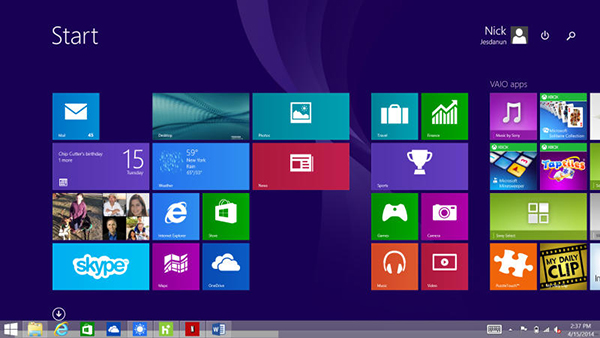

The free update, which became available in April, allows better control of the mouse and new taskbar functions.
Anyone who has their Windows set to automatic update is already likely to have the newest version. You can tell by checking for the magnifying glass icon in the upper right corner of the start-up screen.
Anyone who does not use automatic updates should do a manual update before the deadline. Do so by going to the system settings menu. The necessary update is labeled KB2919355. If that update is not an option, it means you need to first install the previous upgrade: KB2919442.
Twitter send code for new passwords via mobile
Twitter has changed its procedure for resetting passwords. Anyone who needs a new access code will get the code for creating a new password by text message to a mobile phone.
Twitter says the service is intended primarily for users on vacation. Of course, this option is only available for those who have stored a mobile phone number with Twitter. Otherwise, the old method of changing the password via email remains.
Block Chrome from chatting about your searches
There is no doubting the speed of Google's Chrome browser, but it is a chatty tool.
When left on its standard settings, it routinely sends data back to Google, reports German computer magazine c't. That might speed up surfing, but users should still know what kind of information Chrome is sharing and how one can put an end to it.
Most of the pertinent options can be found under the additional settings option in the main settings menu. But things can get really interesting after clicking on the data security option.
Here you can stop Chrome from sending back to Google the addresses typed into the browser window. Remove the tick from the box "Use a web service to help resolve navigation errors."
If you do not want Chrome to share search queries entered into the browser window, also be sure to untick the point "Use a prediction service to help complete searches and URLs typed in the address."
Another option - Use DNS pre-fetching to improve page load performance - tries to let Chrome guess which link will next be clicked by the user so that the necessary material is ready to load immediately.
But this can be a problem if that leads to pages with illegal content.
Users should be aware that using the option "Use a web service to help resolve spelling errors" means all entries into text boxes on websites go back to Google.
Another candidate for shutting off is "Automatically send usage statistics and crash reports to Google." If the browser crashes, Chrome does not just send data about itself, but also about files, applications and services.
But the experts do advise that users leave selected the option "Enable phishing and malware protection," which has the browser regularly review a list of dangerous pages. Bear in mind, the list has to be regularly updated, which means Google will routinely compare visited sites with its lists.
Also make use of the "Send a 'Do Not Track' request with your browsing traffic" option. Doing so signals to companies and advertising networks that the user does not wish a surfing profile to be created.
Learning golf with help from a smartphone
Learning the proper golf technique requires a lot of work but now golfers can practice not only on the green but also on their mobile phones, thanks to a wide range of golfing apps.
They are not all mere gimmicks, says Joerg Schlockermann of the German Golf Association. For beginners especially, the apps can be useful, although they'll never replace an actual coach. Here is a selection:
The Android app Golf Etiquette answers fundamental questions such should I take golf lessons, what basic equipment do I need and are golf shoes strictly necessary?
The Android app Golf Strength Training Workout offers exercises to help a golfer improve their strength and conditioning, both of which can have a positive impact on how far a player can hit the ball. Videos show how to do the exercises properly.
Also an Android app, Golf Swing Analysis allows users to view their own swings and thereby identify weaknesses. A selection of videos showing professionals' swings are included for comparison.
Swing analysis is also available for the iPhone and iPad.
The app Golf Coach & Swing Analysis can show user's swings in slow motion and with zoom. In addition there are lessons from coaches certified by the Professional Golfers Association (PGA). The app is free but only for a limited time.
Labels:
5c,
5s,
android,
Cellcom,
Cellular,
iphone,
iphone4,
mobiles,
phones,
smart,
smartphones,
telecommunication
Tuesday 20 May 2014
Completely redesigned iPhone 6 compared to iPhone 5s, Galaxy S5 in new interactive 3D tool

Are you wondering how Apple’s next-generation iPhone 6 might stack up to leading smartphones like the iPhone 5s and Galaxy S5? We won’t know anything for sure until Apple unveils its new completely redesigned iPhone this fall, but a string of huge leaks has allowed comparison engine Versus to create an awesome 3D tool that might show us how the iPhone 6 stacks up to current leading smartphones.
Versus bills itself as a “sophisticated comparison platform presenting facts stripped of marketing influence.” And now, the latest addition to its unique 3D comparison tool is Apple’s iPhone 6.
The team behind versus says it has “sucked in data from the web about the iPhone 6″ using all of the leaks and rumors we have seen recently as a guideline to create an extremely detailed 3D model of Apple’s next-generation iPhone 6.
Of course there is no way to confirm that it’s an exact likeness of the iPhone 6. It also appears to omit some key details seen on countless mockups — such as the plastic inserts on the back of the phone — and the position of the power button appears to be off.
The overall look and shape is in line with most of the leaks we’ve seen thus far though, and as a result, this nifty interactive tool could give us a very good idea of how the iPhone 6 compares to the iPhone 5s, Galaxy S5 and Galaxy S4.
Apple is widely expected to launch a new iPhone 6 this coming September with a larger 4.7-inch display, an updated A8 processor and a sleek new design. According to insider Ming-Chi Kuo, the new iPhone will also include NFC.
A link to Versus’ comparison tool can be found below in our source section. Simply click and hold on any part of the image and drag your mouse around to see different views of the iPhone 6 as well as the handset it is being compared to.
Labels:
5c,
5s,
android,
Cellcom,
Cellular,
iphone,
iphone4,
mobiles,
phones,
smart,
smartphones,
telecommunication
Monday 19 May 2014
Apple Anticipates Huge Launch for iPhone 6
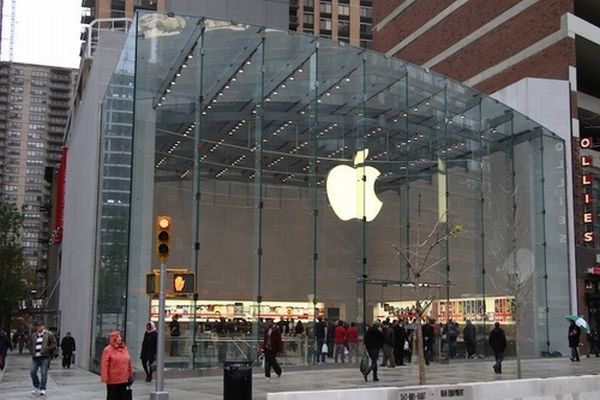
Despite a lack of precise information regarding the details of Apple’s new iPhone, analysts and technology experts are anticipating huge launch numbers for the iPhone 6. These predictions come despite the fact that much remains unconfirmed about the new iPhone, including basic details such as the size, and have led to significant activity in the stock markets as analysts strive to account for the possible impact that a new iPhone could have on the consumer electronics market.
In regards to the size of the new phone, rumor has it that the iPhone 6 will be both larger and thinner than the old 5s model, a move which has been attributed by certain experts as an attempt by Apple to win back market share from Android based phones. These rumors have been supported by the fact that Chinese case makers are already producing cases too large and shallow for any current iPhone. The most recent news regarding the possible appearance of the iPhone 6 come in the form of photos leaked by a French blogger, which indicate that the new iPhone will have a 4.7 inch display and curved edges, culminating in a look that is very comparable to that of the HTC One.
Apple remains dependent on the iPhone in the consumer electronics market, meaning that every new iPhone is important to the future of the company as a whole. However, in light of the recent success of the Galaxy S5, which Samsung claims has sold more units over the first 48 hours than any previous model, Apple may be feeling particularly pressured to produce a higher volume phone in order to keep pace. In fact, Katy Huberty, a long time analyst at Morgan Stanley, has predicted that the iPhone 6 will sell approximately 20 percent more units in the Far East markets than previous models. While this prediction is limited to the Far East markets, it is nonetheless extremely significant given their vast size. As such, analysts have been recommending investment into the American technology giant, as the possibility of huge sales for the iPhone 6 has not yet translated into the stock price of Apple Inc.
The question remains; however, as to what would lead Apple, as well as analysts, to anticipate such a huge launch for the iPhone 6. While there are undoubtedly aspects of the phone that will not be fully understood until the official launch date, there are a number of factors which may have played into this optimism. Among these factors is the rumor that the iPhone 6 will have a screen resolution of approximately 1704 by 960 pixels, which would mark an increase of roughly 400 pixels per inch of screen. Furthermore, Apple is expected to change the screen material of the iPhone 6 to Sapphire Glass, a substance which is allegedly scratch resistant. Finally, it has been reported that Apple and Sony are in talks to collaborate on a new camera, a collaboration which could lead to the iPhone 6 having a camera in the 13 megapixel range.
All of the above factors could lead to increased sales of the iPhone 6, but none can be definitively cited as the main cause for the optimism expressed by Apple. This problem is exacerbated by the fact that none of the details have been confirmed by Apple itself, which leaves much uncertainty for analysts to consider. However, regardless of the reasons for Apple’s anticipation of a huge launch for the iPhone 6, a massive launch would be hugely beneficial for the technology giant. In fact, when combined with the purchase of Beats Electronics, the launch of the iPhone 6 could very well have a decisive impact on the future of Apple as a whole.
Labels:
5c,
5s,
android,
Cellcom,
Cellular,
iphone,
iphone4,
mobiles,
phones,
smart,
smartphones,
telecommunication
Saturday 17 May 2014
Nokia Lumia 630 Dual SIM Review: A New Age for Windows Phone

It's a time of change: The Nokia we've known ever since mobile phones first appeared has finally been acquired by Microsoft and is now officially a subsidiary of Microsoft's Devices Group, which handles the Xbox and Surface product lines. The Lumia 630 is the first new phone out the door since the deal went through, but it's obviously been under development for quite a while. Still, it's obvious that things have changed - subtly but surely, this is the start of something new.
The dual-SIM version of the Lumia 630 has launched in India, and it's the first device to run the newWindows Phone 8.1 update. Interestingly, it isn't a clear replacement for the Lumia 620 - it's a bit cheaper than the 620 was at launch, but is also in a lower segment.
With new hardware and new software to boast of, the Lumia 630 could be quite potent package. Let's take a closer look.

Look and Feel
Nokia seems to have been able to come up with dozens of variations on the same theme: colourful polycarb shell, black front face, buttons all on one side, and simple lines, but different shapes and curves. The 630 is no exception, although this time the shape is more flat and blocky than usual. It's a clean rectangle with sides that taper towards the back, making it fairly easy to grip. The rear bulges only very slightly.
Nokia seems to have been able to come up with dozens of variations on the same theme: colourful polycarb shell, black front face, buttons all on one side, and simple lines, but different shapes and curves. The 630 is no exception, although this time the shape is more flat and blocky than usual. It's a clean rectangle with sides that taper towards the back, making it fairly easy to grip. The rear bulges only very slightly.
Our review sample had a matte-textured white shell. It's definitely nothing like the high-gloss finishes we've seen on some other Lumias, and unfortunately it began picking up dirt and scuffs from almost the first time we set it down on a table.
The front face is blank apart from a Nokia logo up top, since navigation is taken care of by on-screen soft keys now. The power button and volume rocker are on the right edge, but there's no camera shortcut key now. The left edge is totally blank, and the top and bottom have only the headset jack and Micro-USB port each. The back is almost completely blank, with only the camera lens and a round speaker hole to be seen, apart from a faint Nokia logo in the middle.

We don't usually concern ourselves with the boxes that phones come in, but we have to note that Nokia (rather, Microsoft Devices), has switched to a flat, white design, ditching the blocky blue rectangles we've seen with every Lumia release so far. More to the point, the Lumia 630 does not come with a headset or even a USB cable. The charger has a fixed wire with a Micro-USB plug, and we really have to wonder how much money the company will save by not shipping a standard charger head with a removable USB cord.
Features and specifications
The Lumia 630 has a powerful enough processor, the trusty Qualcomm Snapdragon 400. It's a 1.2GHz quad-core system-on-a-chip with integrated Adreno 305 graphics. There's only 512MB of RAM which is a significant step down from the 1GB found in the 620 and even the cheaper Lumia 525.
The Lumia 630 has a powerful enough processor, the trusty Qualcomm Snapdragon 400. It's a 1.2GHz quad-core system-on-a-chip with integrated Adreno 305 graphics. There's only 512MB of RAM which is a significant step down from the 1GB found in the 620 and even the cheaper Lumia 525.
As other manufacturers have done recently, Nokia has used a dedicated processor for sensor input which allows the main SoC to power down and save battery life. The SensorCore, as it's called, ties in to the Bing Health and Fitness app which can act as a pedometer and activity tracker. This won't be a big feature for the Lumia 630 considering it lacks advanced sensors, but higher end devices such as the upcoming Lumia 930 will take better advantage of it.
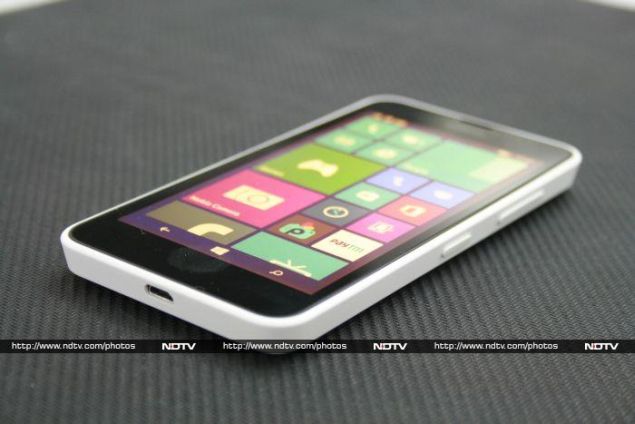
You get 8GB of built-in storage space, which is somewhat offset since Nokia says up to 128GB microSD cards are supported. The screen is 4.5 inches diagonally, but has a lowly resolution of 480x854 pixels. This is by far the lowest pixel density we've seen in a long time, and it's very evident at first glance that this is not a premium quality display at all. It's duller than we've come to expect from Nokia, with less-than-impressive colour accuracy and poor viewing angles. The Windows Phone interface isn't terribly grainy, but text in apps and on websites reminds us of what used to be considered high-quality a decade ago.
The screen is proportionately a bit taller than the one on the Lumia 525, and its resolution is very slightly greater than 16:9 which is a good thing because a bit of vertical space is lost to the on-screen buttons (which are almost permanently visible).
Wi-Fi and Bluetooth support is up to date, and there's also GPS. The only sensor seems to be an accelerometer - there isn't even an ambient light sensor to help adjust screen brightness automatically. All in all, the Lumia 630 has a somewhat unbalanced list of features - it's outclassed in some areas by other phones in its price range.
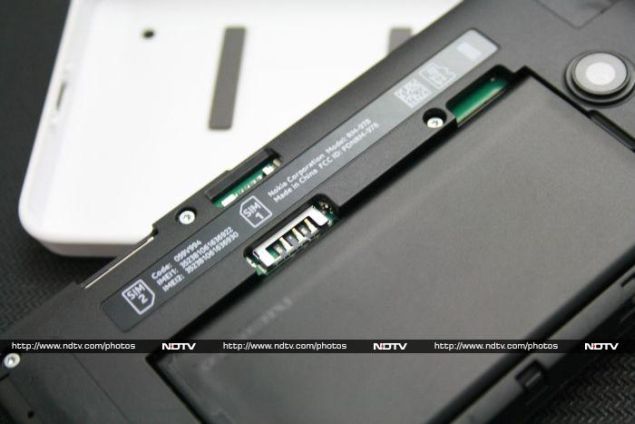
Software
The biggest story of course is Windows Phone 8.1. Microsoft's update is fairly significant, with plenty of improvements both major and minor. The one thing Microsoft can boast about abroad is Cortana, its version of a voice-based intelligent assistant, but that it doesn't work in India. Tweaks to get it running do exist, but for all practical purposes, this isn't a feature to take into consideration yet.
The biggest story of course is Windows Phone 8.1. Microsoft's update is fairly significant, with plenty of improvements both major and minor. The one thing Microsoft can boast about abroad is Cortana, its version of a voice-based intelligent assistant, but that it doesn't work in India. Tweaks to get it running do exist, but for all practical purposes, this isn't a feature to take into consideration yet.
The other visible change is - finally - the addition of a notification shade, which Microsoft has named Action Centre. Just like in Android and iOS, you can swipe downwards from the very top of the screen to pull down an overlay which displays notifications you haven't dealt with yet. When you pull down the Action Centre shade, you'll see expanded information about your notification bar icons, such as the battery level in percent. There are also four handy shortcuts: Wi-Fi, Bluetooth, Camera and Brightness, and you can swap these out for other choices, but can't have more than four.
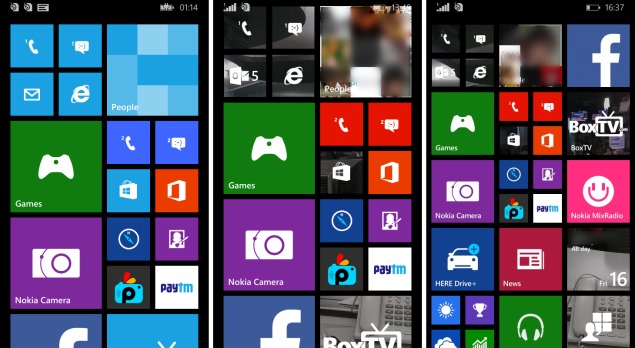
The brightness control is handy since the Lumia 630 doesn't adjust it automatically, and the camera shortcut somewhat makes up for the loss of the dedicated physical button. We would have liked to have had more shortcuts, but have to make do with clicking through to the Settings app.
The much-publicised background photo option only works well with some photos, and if you arrange your Start screen tiles carefully. Simple patterns work better than actual photos. You can also fit a third column of large tiles, but this looked terrible on our Lumia 630 thanks to the low-res screen.
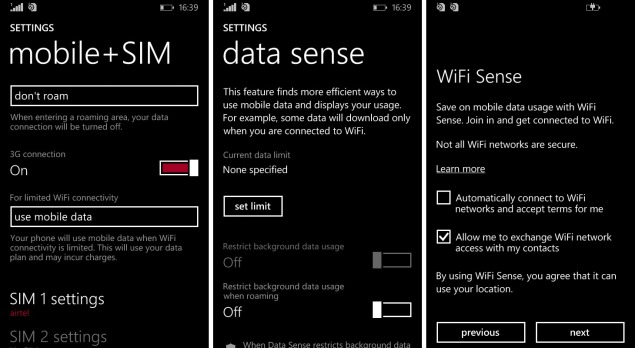
The Lumia 630 is the first dual-SIM Windows Phone, so there are a few unique touches in this regard. For starters, there are two distinct phone and messaging apps, which is a very odd and potentially confusing way to handle things. The icons for each SIM card are only slightly different in colour (and the first set goes transparent if you use the new background photo option). You'll have to deal with fragmented call history lists and inboxes, although the contact list is shared and you can choose to send a message or make a call from a different SIM even from the other SIM's apps. This could help keep work and personal communications separate, but not everyone will like this approach.
There are a new few apps and tweaks too - Battery Saver does exactly what it sounds like and lets you check which apps have been draining your battery the most. Data Sense allows users to define cellular data usage limits, and Wi-Fi Sense is a unique tool that can automatically sign you in to password-protected Wi-Fi hotspots that your friends have used in the past. Yet another tool called Storage Sense lets you manage apps, clear caches and swap things around between the internal storage and microSD card.
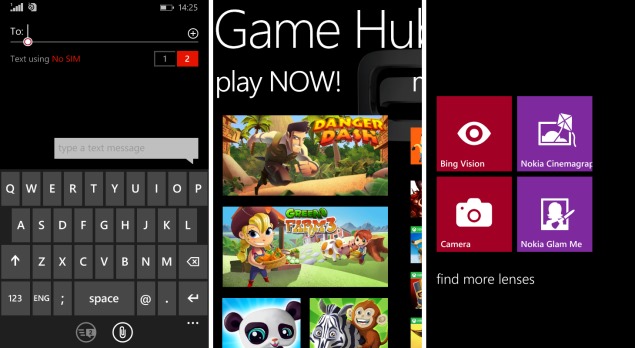
Less visible are tweaks to the keyboard, which now lets you drag a finger between letters, Swype-style. Skype and OneDrive are more deeply integrated, and Internet Explorer has received a few improvements under the hood. While a lot of common complaints have been addressed, the Windows Phone experience is still not without its own unique problems. The on-screen buttons are visible even when playing video full-screen, the Back button still behaves illogically, and the Marketplace is still highly lacking, compared to the Google Play store and iOS App Store.
Nokia had a proud tradition of improving upon Microsoft's work even further. The Lumia 630 comes with a set of additional features collectively known as Lumia Cyan, which includes an extended set of photography apps. Also present are Nokia's other trademark features, Here Maps, Here Drive+, and Nokia MixRadio. Surprisingly, the highly useful Glance screen, which in other Lumia models lets you see notifications while the screen is off, has been cut out.
The Lumia 630 comes with a lot of third-party apps too: BoxTV, Evernote, Facebook, Flipkart Ebooks, Gameloft Gamehub, Line, PayTM, and Zomato.
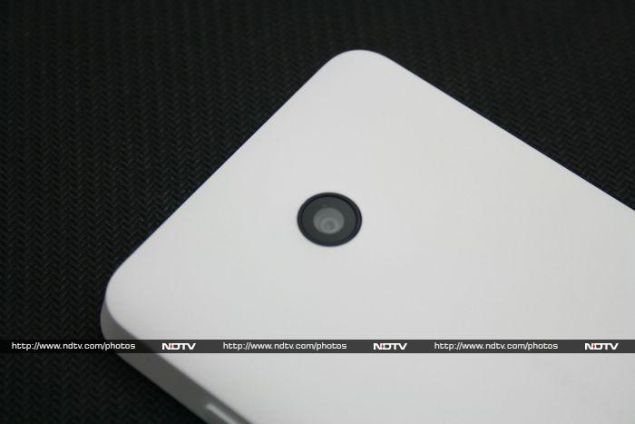
Camera
Nokia always throws in a lot of camera apps, and this time we have Cinemagraph, Creative Studio, and Glam Me for a variety of effects ranging from animation to face enhancement. Options in the Nokia Camera app include shutter speed and manual focus, and you have quick access to ISO and white balance settings.
Nokia always throws in a lot of camera apps, and this time we have Cinemagraph, Creative Studio, and Glam Me for a variety of effects ranging from animation to face enhancement. Options in the Nokia Camera app include shutter speed and manual focus, and you have quick access to ISO and white balance settings.
We were very impressed with the photos we took in daylight. The details and clarity were good enough to make us think our test shots had been taken with phones which cost twice as much. Things weren't as great indoors, and we saw noise increase drastically even in pictures of our well-lit office floor. Photos taken at night were full of noise and lacked detail. Video was blocky and compressed, with an artificial quality to it.
We would have been grateful for a flash, but we didn't miss having a front camera as much. At this price point, a front camera would be so low quality that we'd rarely use it anyway.

(Click to see full size)
Performance
As expected, Nokia and Microsoft's curious decisions regarding the Lumia 630's configuration made a big impact on the device's performance. The biggest issue we ran into was that some tests, such as GFXbench, simply could not be installed thanks to the low amount of RAM. Users will face this problem with other apps as well. The two companies might have decided that 512MB was enough for WP8.1, but again, we wonder how much it would have hurt to stay with 1GB.
As expected, Nokia and Microsoft's curious decisions regarding the Lumia 630's configuration made a big impact on the device's performance. The biggest issue we ran into was that some tests, such as GFXbench, simply could not be installed thanks to the low amount of RAM. Users will face this problem with other apps as well. The two companies might have decided that 512MB was enough for WP8.1, but again, we wonder how much it would have hurt to stay with 1GB.
Benchmark scores in other tests, such as SunSpider and the Windows Phone version of AnTuTu were slightly higher than or at par with those for comparable WP8.0 phones, such as the Lumia 525, but well below those of the mid-range Lumia 1320.
The interface feels smooth enough, but Web browsing was a bit laborious and even non-HD video clips often felt jittery. We aren't confident that the Lumia 630 will hold up for more than a year or two, especially if you load it up with apps, and if future OS updates require beefier specifications.
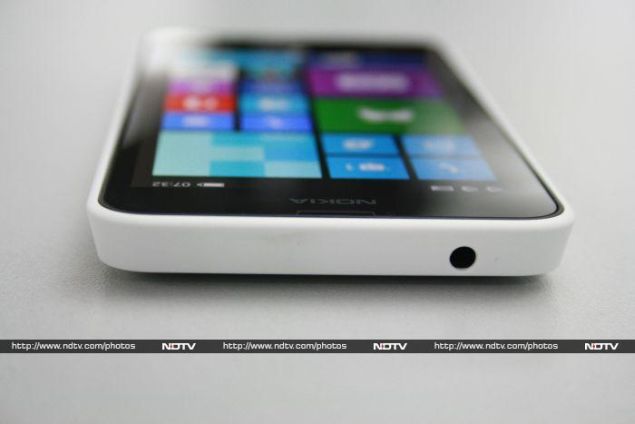
The screen's low quality was very apparent when watching videos. It isn't completely terrible, but we're now used to at least 720x1280, and there is a perceptible difference.
Battery life was impressive at just a shade over 11 hours in our video loop test. We're confident that we could use this phone intensively through a full day of work and not be left scrambling to find a power outlet.
Verdict
We're happy with most of the improvements we've seen in Windows Phone 8.1, but there is still work to be done. We hope minor issues such as the always-on soft buttons are taken care of soon, and we look forward to spending more time with the Sense tools. That said, we have a few reservations when it comes to the Lumia 630 itself.
We're happy with most of the improvements we've seen in Windows Phone 8.1, but there is still work to be done. We hope minor issues such as the always-on soft buttons are taken care of soon, and we look forward to spending more time with the Sense tools. That said, we have a few reservations when it comes to the Lumia 630 itself.
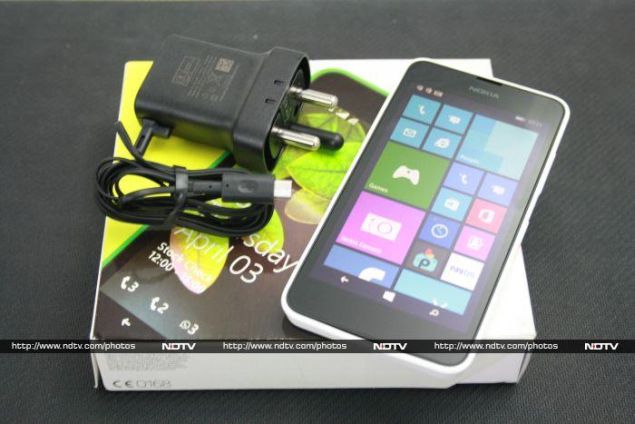
It's a solid workhorse phone with good construction quality and phenomenal battery life, and of course the assurance of Nokia's brand name and dealer/service network are big plusses. It's also stylish, and some people do respond very well to Windows Phone's unique look. What it comes down to is the Lumia 630's fairly unique combination of capabilities - if you like Windows Phone and need a dual-SIM device with a large screen, you'll be happy with it. If you care about gaming, movies or longevity, you should seriously think of spending just a little more money for a better device.
The step down to 512MB RAM and the absence of a flash are inconvenient, not dealbreakers, but customers who choose Android phones in the same price band won't have to make similar compromises. Moreover, there are also far better phones such as the Moto G which cost only very little more. We feel as though the Lumia 630 will be more competitive once its price drops by around Rs. 1,000 - 2,000.
Labels:
5c,
5s,
android,
Cellcom,
Cellular,
iphone,
iphone4,
mobiles,
phones,
smart,
smartphones,
telecommunication
Subscribe to:
Posts (Atom)
